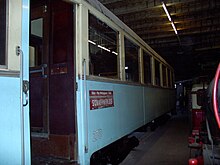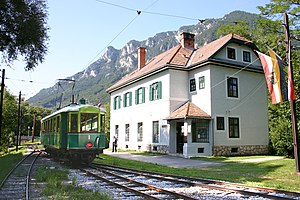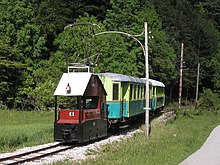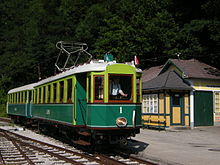Höllentalbahn (Lower Austria)
| Payerbach-Reichenau-Hirschwang | |||||||||||||||||||||||||||||||||||||||||||||||||||||||||||||
|---|---|---|---|---|---|---|---|---|---|---|---|---|---|---|---|---|---|---|---|---|---|---|---|---|---|---|---|---|---|---|---|---|---|---|---|---|---|---|---|---|---|---|---|---|---|---|---|---|---|---|---|---|---|---|---|---|---|---|---|---|---|
|
Operations building in Reichenau (Schlossplatz 2) with railcar 1
| |||||||||||||||||||||||||||||||||||||||||||||||||||||||||||||
| Route length: | 4.9 km, originally 6.1 km | ||||||||||||||||||||||||||||||||||||||||||||||||||||||||||||
| Gauge : | 760 mm ( Bosnian gauge ) | ||||||||||||||||||||||||||||||||||||||||||||||||||||||||||||
| Power system : | 550 V = | ||||||||||||||||||||||||||||||||||||||||||||||||||||||||||||
| Maximum slope : | 25 ‰ | ||||||||||||||||||||||||||||||||||||||||||||||||||||||||||||
| Minimum radius : | 60 m | ||||||||||||||||||||||||||||||||||||||||||||||||||||||||||||
| Top speed: | 25 km / h | ||||||||||||||||||||||||||||||||||||||||||||||||||||||||||||
|
|||||||||||||||||||||||||||||||||||||||||||||||||||||||||||||
The Lower Austrian Höllentalbahn is a narrow-gauge , electric local train with a track width of 760 mm, which runs from the ÖBB station Payerbach-Reichenau on the Semmeringbahn on an approx. 5 km long route via Reichenau an der Rax to Hirschwang to the beginning of the Höllental . Today it is only operated as a museum railway.
history

The railway started operating in 1918 as a material web for a paper factory and, after the license was granted in 1922 and several deadlines extended until 1926, it was expanded into a local railway transporting people and goods.
The railway was originally planned as a standard gauge line, but this failed because of the costs, although significant preparatory work had already been carried out. So 1918 was from the 428 m long Artzbergtunnel who should cross the ridge of the same name between Payerbach and Reichenau, Sohlstollen already been completed, but not the first tunnel . The tunnel entrances were filled in after the project was abandoned.
In addition to local commuter traffic , the line, which was extended by a continuation line on the basis of the license granted in 1927, also served day trippers as a feeder to the Rax cable car , also opened in 1926 , the first cable car in Austria. At the beginning of the 1960s, larger investments would have been necessary for the continued existence, which is why passenger transport was discontinued in 1963 and replaced by post buses. Freight traffic, particularly to the paper mill in Hirschwang, could continue to operate until 1982.
Passenger traffic was geared towards the connections at Payerbach-Reichenau station, with up to 16 pairs of trains running daily.
In 1977 the Austrian Society for Local Railways (ÖGLB) was founded, which has been running a museum on weekends in summer with Höllentalbahn Projekt Ges.mbH (HPG) since 1979 and has also been responsible for maintaining the route since all traffic was discontinued. Due to the poor condition of the track, it was only possible to travel between Reichenau and Hirschwang from 1993 to 1999, and in 2015 the museum railway season was canceled due to the lack of an operating permit. The original railway operator, the local railway Payerbach-Hirschwang GmbH, still exists in the sense of commercial law, appears in the Austrian commercial register in 2007 and still publishes an annual balance sheet .
Coordinates: 47 ° 41 ′ 53 " N , 15 ° 50 ′ 21.7" E
route
The Höllentalbahn has its starting point at the Payerbach-Reichenau station of the Semmeringbahn. The former departure platform was located opposite the ÖBB station building and was accessible through an underpass. Subsequently to the west was the goods transshipment point where transhipment between standard gauge and narrow gauge was carried out. The next stop was the Payerbach-Ort stop, which today, known as the Payerbach Local Railway, is the starting point of the museum railway. After the stop, the route begins to rise at 25 ‰. The route follows the Semmering Railway for a while, and then branches off to the right. After almost a kilometer ascent, the highest point on the route is reached on the Artzberg. Then it goes downhill again at 25 ‰ through the forest. At kilometer 2, the train reaches the Kurhaus stop and then runs through the Thalhofgraben in a 270 ° bend to lose further altitude.
The material web before 1926 had two switchbacks at this point. Subsequently, the Kurhausbrücke leads over the first Viennese spring water pipeline and a walking path.
Soon after, the three-track Reichenau station is reached. Here in the middle of the route is the electrical converter that supplies the route with electricity. Further towards Hirschwang, it goes slightly uphill along the Schwarza . First the route runs through built-up area, later between river and forest. The Haaberg stop is at kilometer 4.3, the Hirschwang stop is at kilometer 5. The latter was built in 2006 at the junction to the remise and has since been the end of the museum trains. The 200-meter route to Hirschwang station and the station building are in poor condition and are only rarely used. At the time of the local railway, Hirschwang station had four tracks, two each for passenger and freight traffic. The freight tracks led to the connecting line of the paper mill. There were also sidings to a sawmill, a lime and stone works and an accumulator factory. After the passenger train journey, the route continued along the factory halls in the direction of Höllentalstraße. Before it was crossed, the trains stopped at the Fabrik stop. The route also followed the Höllentalstraße and ended shortly before the road crosses the Schwarza over the wind bridge. The terminus of the Windbrücke-Raxbahn was single-track, so that the trains had to be pushed into the siding 100 meters in front of the stop.
vehicles

The E1 – E3 electric locomotives are the symbol of the railway. Originally, they were used with several sister locomotives to build the Karawanken railway tunnel . After several renovations, they got their characteristic appearance, which earned them the nickname "moving garden house". Built in 1903, they are among the oldest operational electric locomotives in the world. Another electric locomotive (E4) was delivered by AEG Vienna in 1927, but this was only used for the factory shift in Hirschwang.
In 1926, two railcars (No. 1 and 2) and four trailer cars (No. 11 to 14) were built by the Grazer Waggonfabrik for passenger transport . These cars were very generously dimensioned and at that time also the largest narrow-gauge vehicles in Austria. Until 1963, they carried all passenger traffic. After it was discontinued, they were sold to the Zillertalbahn . The sidecars were used there as passenger cars with various modifications, but the car bodies of the railcars were scrapped and freight cars built on their frames. The sidecars could be brought back to their old home in 1986. Two of them (No. 11 and No. 12) were painted in the original colors and used in museum traffic. It should take a little longer before a railcar can be rebuilt. It was not until 1999 that work began on reconstructing a railcar true to the original from the remaining bogies and a car body of a sidecar. This was put into operation at the start of the 2005 season. The former Badner Bahn sidecar 270 (from 1971 it was number 74, after retiring from regular operation the number 270 was written on the outside again), built by Ringhoffer in Prague, has been on the road on the Höllentalbahn since 2003 . It was re-gauged by swapping the bogie and put into operation with the number 21 in Höllental.
After the condition of the electrical systems had deteriorated in the 1970s, a total of two Heeresfeldbahn diesel locomotives of type HF 130 C were purchased . These were sold again after the freight traffic was discontinued, and a machine of this type has been on the museum railway again since 1997 (referred to as V2). In addition, smaller diesel locomotives were repeatedly used to move the works and for construction trains. A Jenbacher diesel locomotive has been on the Höllentalbahn (referred to as V10) since 1986, which was originally used by the Böhler works in Kapfenberg .
Steam locomotives were first brought to this route by the museum railway. In addition to some factory or field railroad twin couplers (Floriana, built in 1913 and Böhler 17, built in 1943), the U1 (ÖBB 298.51) and the "Molln" (ÖBB 298.104) also ran the route for a short time . In 1990 the ÖGLB association took over the Ybbstalbahn mountain line as the second railway and transferred the large steam locomotives there. The steam locomotives Floriana and Böhler 17 were also no longer refurbished after being dismantled, but sold.
literature
- Alfred Luft, Werner Schiendl: The local railway Payerbach - Hirschwang. (L. B. P. - H.) . 1st edition. ÖGLB, Austrian Society for Local Railways, Vienna 1979, ÖNB .
- Helmut Bribitzer, Werner Schiendl: The vehicles of the local railway and the museum railway Payerbach-Hirschwang . 1st edition. ÖGLB, Austrian Society for Local Railways, Vienna 1983, ÖNB .
- Markus Strässle: Narrow-gauge railway activities in Austria . International Archive for Locomotive History , Volume 43, ZDB -ID 256348-4 . Slezak, Vienna 1997, ISBN 3-85416-184-0 .
- Werner Schiendl : The Austrian Society for Local Railways . Kenning Verlag, Nordhorn 2005, ISBN 3-933613-53-1 .
Individual evidence
- ^ Announcement of the Federal Ministry of Transport from November 17, 1922, regarding the granting of the concession for a narrow-gauge local railway from the Payerbach-Reichenau station of the Südbahn-Gesellschaft to Hirschwang. In: BGBl 1922/828 , year 1922, pp. 1639–1643. (Online at ANNO ). .
-
↑ Announcement of the Federal Ministry for Trade and Transport of August 30, 1923, regarding the extension of the deadline for the completion of construction and opening of the local railway from Payerbach to Hirschwang. In: BGBl 1923/511 , year 1923, p. 1693 f. (Online at ANNO ). as well as the
announcement of the Federal Ministry of Trade and Transport of August 30, 1924, regarding the extension of the deadline for the completion of construction and the opening of operations for the local railway from Payerbach to Hirschwang. In: BGBl 1924/331 , year 1924, p. 1162 f. (Online at ANNO ). . - ↑ Announcement of the Federal Ministry of Trade and Transport of August 13, 1925, regarding the granting of the concession for a small cable car to be operated with electric power from Hirschwang-Raxbahn to the Raxalpe. In: BGBl 1925/319 , year 1925, p. 1092 ff. (Online at ANNO ). .
-
↑ Announcement of the Federal Ministry for Trade and Transport of August 7, 1925, regarding the extension of the deadline for the completion of construction and opening of the local railway from Payerbach to Hirschwang. In: BGBl 1925/316 , year 1925, p. 1091. (Online at ANNO ). as well as the
announcement of the Federal Ministry of Trade and Transport of June 25, 1926, regarding the extension of the deadline for the completion of construction and opening of the local railway from Payerbach to Hirschwang. In: BGBl 1926/171 , year 1926, p. 682. (Online at ANNO ). . - ^ History of the material web (accessed July 15, 2016).
- ↑ Announcement of the Federal Ministry of Trade and Transport of August 17, 1927, regarding the granting of the concession for a continuation of the narrow-gauge Payerbach-Hirschwang local railway from the Hirschwang terminus to Windbrücke-Raxbahn. In: BGBl 1927/261 , year 1927, p. 1130. (Online at ANNO ). .
- ↑ Markus Inderst: Narrow gauge exotic at the foot of the Rax . In: railway magazine . No. 11 , 2018, ISSN 0342-1902 , p. 45 .
- ↑ History of the museum railway (accessed February 15, 2019).
- ↑ Timeline of the Höllentalbahn (accessed February 15, 2019).
Remarks
-
↑ At the end of 1894, in relation to a long cherished project , the Imperial and Royal Ministry of Commerce of the well-known factory for electrical lighting and power transmission, B. Egger and Comp. in Vienna (see: Tram Gmunden ) , the permit to carry out technical preparatory work for a standard-gauge electric train from Payerbach, Südbahnhof via Reichenau to the Prein was granted. - See: Payerbach. (Electric train in the Prein.). In: Badener Bezirks-Blatt , No. 1/1895 (15th year), January 2, 1895, p. 6, bottom left. (Online at ANNO ). .
The route revision for this project was approved as early as 1896. - See: Railway Payerbach – Hirschwang – Prein. In: Communications of the German and Austrian Alpine Club , year 1896, (Volume XXII), p. 264, bottom left. (Online at ALO ).
50 interested parties took part in the route revision on January 8, 1897. The 1000 mm track was planned for 11.5 km and included a branch line to Thalhof . The planned travel times were: Payerbach – Edlach – Dörfl – Prein 42 minutes, Payerbach – Hirschwang 30 minutes. The electricity generating central station should be built next to the Payerbach train station. - See: Heavy current systems. Austria-Hungary. a) Austria. (...) Payerbach – Hirschwang. Electric small train . In: Josef Kareis (Red.): Journal for electrical engineering . Volume 15.1897, issue 2/1897, January 15, 1897, ISSN 1013-5111 . Lehmann & Wentzel ( Commission ), Vienna 1897, p. 56. - Text online . - It can be assumed that such a project was not primarily aimed at the local economy, but at the tourist development of the Rax area.
In 1908 there was a plan to let the line over the Semmering exist as a local or luxury train, when a new line of the southern train branching off from Payerbach station via Reichenau, Hirschwang, Prein, Hohlensteinertal (today: Hollensteingraben), the massif of the Tratenkogel (1565 m) crossing under, after Mürzzuschlag is built. - See: Heinrich Heß (Red.): Communications of the German and Austrian Alpine Club : Transport and Accommodation. (...) A new railway line in the Semmering area , No. 12/1908, (XXXIV. Year), p. 164. (Online at ALO ).
In 1913, a lower-order electric railway leading to Prein was to be extended to the Rax plateau. - See: Little Chronicle. (...) Pre-concession for an electric train on the Semmering and the Rax. In: Neue Freie Presse , Morgenblatt, No. 17516/1913, May 30, 1913, p. 9, center right. (Online at ANNO ). . - ↑ Overall length: 0.867 km; Opening: October 2, 1927; Closing of operations: July 1, 1963; Discontinuation order: Decision of the Federal Ministry of Transport and Electricity from October 24, 1963, Zl. R / 1424/43. - 9th Hirschwang – Windbrücke / Raxbahn . In: Hellmuth Fröhlich: Forgotten rails . In: Railway. Technical supplement "Die Modelleisenbahn" . Volume 21.1968, issue 5.Minirex, Lucerne 1968, ISSN 0013-2756 , OBV , p. 72.
- ↑ From the end of September 1927, changing at the Payerbach-Reichenau train station could take place directly ; the terminus of the local railway had also been moved to the immediate vicinity of the valley station of the Raxbahn. - See: Local report. (...) The local railway Payerbach – Hirschwang. In: Neue Freie Presse , Morgenblatt, No. 22644/1927, October 1, 1927, p. 8, center right. (Online at ANNO ). .






